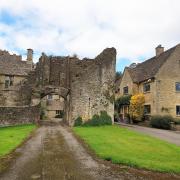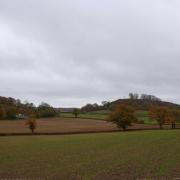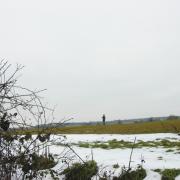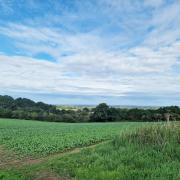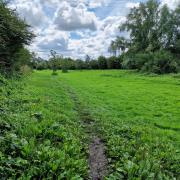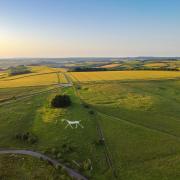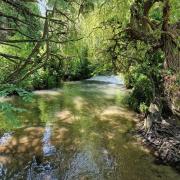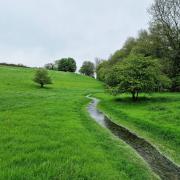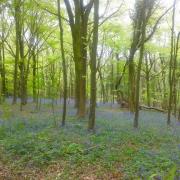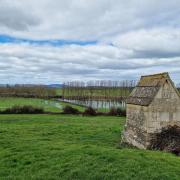A wintry walk from Kingswood, near Wotton-under-Edge, on the trail of ghostly monks and mysterious bakers at the start of the farming year.
Midwinter is past, that still point of the year outdoors which makes a space to party indoors! Now that the days are getting longer again, and the Christmas holidays are over, the work begins once more. The agricultural year traditionally began on the first Monday after Epiphany – Plough Monday.
Better remembered these days are the wassails on Twelfth Night, when the apple trees are blessed to bring a good harvest (and good cider!). That used to be the time for the Twelfth Cake. A pea and a bean were baked within it. Whoever got the pea would be Queen, and the bean, King, and would lead the revels on that last night of partying before everyone went back to work. But it wasn’t quite the end of the fun. In some parts of the country a plough would be decorated and blessed in the church on Plough Sunday, and on Plough Monday the ploughmen would dress up and drag the plough from house to house, asking for money, food, or drink. At Ettington in Warwickshire the tradition continued till the 1930s.
These celebrations remind us that ploughmen were out in the cold, wet, and wind at the beginning of the year, cutting the sod so the seeds could be sown, so that everyone would have food to eat. This month’s walk takes us to Kingswood, near Wotton-under-Edge, where one crisp morning in January a certain ploughman walked out with his oxen into the fields. Our walk will take in his story, and another one more remote in time, and begins at the one surviving part of Kingswood Abbey – its gatehouse.

The abbey was founded in the 12th century by the Berkeley family as a daughter house of the Cistercian abbey at Tintern. The little gatehouse, with its lily tracery and its niches once filled with statues, hints at the splendour of the lost abbey. Look up in the archway and you’ll see green men and wild boar lurking in the vault. Kingswood Abbey was dissolved during the Reformation. The story goes that some of the monks, fearing persecution, fled through a tunnel that ran from the abbey through the hills to the east.

Walk between the gatehouse and the modern church and through the churchyard, taking the path to the left. At the end of a row of bungalows turn left over the stream and continue straight ahead along a drive and cement track. Climb the stile in front of you to enter the field where our ploughman was working that chilly winter morning. While he was toiling there with oxen and plough, he suddenly heard a cry. And then another. It came from the earthworks along the field’s eastern edge. Was he hearing the haunting voices of those fleeing monks long ago? Maybe the long earth banks and fosse were a relic of their tunnel.
The wailing cries resolved into words: ‘Oh no, I have lost my peel!’

A ‘peel’ is a long-handled implement for getting bread and cakes into an oven. Not very ghostly! But there was no sign of any oven in this field, or of any people. When the ploughman went to investigate, he found a tiny doll’s-size peel, snapped in two. Now whose could that be? He picked up the pieces and popped them in his pocket. That night at home, he mended the little peel as he would his daughter’s toys. Next morning, he put it back where he’d found it, and thought no more about it as he went on with his ploughing. At the end of the day’s work, he smelt something he’d not expected to smell till the next feast day: the boozy, sweet smell of a fruitcake. It came from the earthworks where he’d left the peel. He hurried over, and there, on the peel, sat the tiniest of cakes. It was only a morsel but it tasted so good! Well, we know that it’s unwise to eat fairy food, but in this case it was all right because he’d helped the fairies. This was just a sweet thank you.

Having walked through this field and the next, take the bridleway to the right to Leys Farm and onwards till you meet a lane. Turn left up this lane, which after crossing a road becomes a lovely, shady bridleway up Tor Hill. This is roughly the route of the tunnel from Kingswood Abbey.
The night the monks made their escape, fumbling along in the dark, they didn’t all stay together. Some were speedier than others, and the tunnel was more complicated than they’d thought. It contained a junction. When one group arrived there, they went right. A little later a straggler went left. He struggled along a bit further, then emerged into blinding sunshine in the old quarries at Black Quarr, just north of Tor Hill. He waited and waited, but none of his brothers appeared. At last he hurried away, five miles north, to Owlpen Manor. He thought he’d be safe there, the family hid him in a priest’s hole, but something went wrong. Was he forgotten? Did the family have to leave in a hurry? It’s said that he starved to death and haunts the manor still.

His brothers fared no better. The branch of the tunnel they’d chosen was unstable and when the roof caved in they ended up trapped. By a weird irony, it was above that very spot that Kingswood Abbey’s new owner, Nicholas Poyntz, built a hunting lodge using stone from the abbey church. This is Newark Park, now owned by the National Trust, and haunted by the monks’ ghosts. If you want to visit Newark Park, bear left when the bridleway meets the Cotswold Way just after a gate on Tor Hill, and after half a mile head right a short way along a road till you reach the driveway into the property.

Otherwise, bear right along the Cotswold Way as it curves east and then south along the edge of the woods. Newark Park stands just half a mile east of here but it’s hard to spot. The route descends through the wood – busy with pheasant shooting in November – to the lane into the hamlet of Wortley. The right of way past the farmhouse across the road has been diverted as a ‘permissive path’ through a copse and field which leads, via a stile, back to the proper path. In the next field corner, take the stile on the left to a path that crosses diagonally through three fields. In the far corner of the third, climb the stile on the right, then cross the road and another stile and follow the footpath that turns sharp left around a bend in the stream and back to Kingswood. An urban footpath skirts an industrial site to lead you back to the churchyard.
Having walked through so much farmland in this winter season, perhaps we should take a pious moment to remember all the farmworkers at the start of the farming year: ‘So jolly folks now, here’s God speed the Plough, / Long life and success to the Farmer!’
Essentials
Distance: 5 miles.
Duration: 3 hours.
Level: Moderate walking with a number of stiles and some inclines.
Parking: Road parking in Kingswood.
Toilets and refreshments: Dinneywicks, Kingswood; Newark Park Tea Pavilion (weekends only in winter).
Transport links: There’s no regular bus service to Kingswood at present, so you’d need take a taxi – or extend the walk – from Wotton-under-Edge.
Map: OS Explorer 167: Thornbury, Dursley & Yate
Further reading: Gloucestershire Folk Tales for Children by Anthony Nanson and Kirsty Hartsiotis.
Links
Route: gb.mapometer.com/walking/route_5322176
Kingswood Abbey Gatehouse: www.english-heritage.org.uk/visit/places/kingswood-abbey-gatehouse
Newark Park: nationaltrust.org.uk/newark-park
Kirsty Hartsiotis and Anthony Nanson are based in Stroud and available for hire as storytellers and speakers. Their books include Gloucestershire Folk Tales, Wiltshire Folk Tales, Gloucestershire Ghost Tales, and Gloucestershire Folk Tales for Children. Kirsty is also the curator of decorative and fine art at a Gloucestershire museum. Anthony runs the small press Awen Publications.






